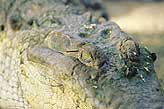Cautious Hopes For The Orinoco
continued
According to Anita Mendez-Reyna from the NGO Tierra Viva
Foundation (an offshoot of Living Earth Foundation), the resulting
salinization of land and water has forced the Warao natives to
migrate to cities or concentrate in high-density dwellings - begging
for food, because their natural gathering and hunting grounds have
been ruined. But the river is still buoyant with water and
resources. New generations have arrived, and their knowledge is more
extensive.
 |
|
| ę WWF/J Pratginestos Crocodile,
Orinoco |
|
The opinions of biologists
and ecologists now count, and NGOs are collaborating with the
authorities. An old project known as PROA (its Spanish initials)
aimed at building dams, locks and lakes to increase the navigability
of the Orinoco-Apure system has been thoroughly revised. Adalberto
N˙˝ez, the agricultural engineer in charge of PROA, said that the
project has been modified to guarantee minimum environmental impact,
and he supported his statement by pointing to the cooperation he
receives from the World Wide Fund for Nature, the University of the
Llanos, Fudena (WWF's Venezuelan counterpart), La Salle Foundation,
the University of Florida and various NGOs.
The socio-political component of the project visualizes many
small settlements along the river banks to house about 5m
inhabitants coming from the overpopulated Venezuelan coastal areas.
Adalberto N˙˝ez claims he has an interdisciplinary team of 120
professionals to plan the future of the llanos and the welfare of
Venezuela. Deborah Bigio, Fudena' s director, concedes there are
favourable factors and willing cooperation from PROA. Fudena is
participating in a river model and in the geographical information
system.
PROA promotes collaboration among all the participants to gather
and share available information. Donald Taphorn, ictiologist from
the Llanos University recognizes that governmental institutions are
changing for the better. PROA now consults, listens and modifies its
plans accordingly. The project switched from big ships to smaller
barges and these will only navigate during the 6 rainy-season
months. They will not dredge the river, and there will be no locks
or dams.
Gernant Magnin, from the WWF Living Waters Campaign, is
cautiously optimistic. "WWF, in a unique cooperation with its
counterparts in Venezuela and Colombia and the relevant ministries
in the two countries, has initiated the development of a
three-dimensional hydrological model of the entire basin. This tool
(a global first on this scale) will allow the authorities to predict
what the effects will be of, for example, the construction of a dam
on the areas downstream. We are convinced that with modern
technology and good planning, the Orinoco river can be developed so
that its ecological qualities are preserved for generations to
come."
<
Back



